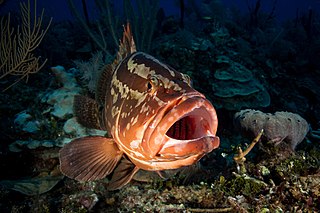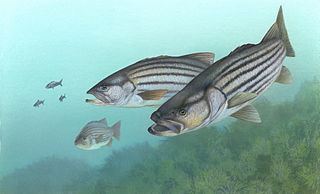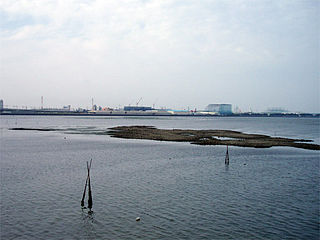Related Research Articles

The striped bass, also called the Atlantic striped bass, striper, linesider, rock, or rockfish, is an anadromous perciform fish of the family Moronidae found primarily along the Atlantic coast of North America. It has also been widely introduced into inland recreational fisheries across the United States. Striped bass found in the Gulf of Mexico are a separate strain referred to as Gulf Coast striped bass.

Bass fishing is the recreational fishing activity, typically via rod-based angling, for various game fishes of North America known collectively as black bass. There are numerous black bass species targeted in North America, including largemouth bass, smallmouth bass, spotted bass or Kentucky bass, and Guadalupe bass. All black bass species are members of the sunfish family Centrarchidae.

Angling is a fishing technique that uses a fish hook attached to a fishing line to tether individual fish in the mouth. The fishing line is usually manipulated via a fishing rod, although rodless techniques such as handlining also exist. Modern angling rods are usually fitted with a fishing reel that functions as a cranking device for storing, retrieving and releasing out the line, although Tenkara fishing and traditional cane pole fishing are two rod-angling methods that do not use any reel. The fish hook itself can be additionally weighted with a denser tackle called a sinker, and is typically dressed with an appetizing bait to attract and entice the fish into swallowing the hook, but sometimes an inedible fake/imitation bait with multiple attached hooks is used instead of a single hook with edible bait. Some type of bite indicator, such as a float, a bell or a quiver tip, is often used to relay underwater status of the hook to the surface and alert the angler of a fish's presence.

The Nassau grouper is one of the large number of perciform fishes in the family Serranidae commonly referred to as groupers. It is the most important of the groupers for commercial fishery in the West Indies, but has been endangered by overfishing.

The bluegill, sometimes referred to as "bream", "brim", "sunny", or, as is common in Texas, "copper nose", is a species of North American freshwater fish, native to and commonly found in streams, rivers, lakes, ponds and wetlands east of the Rocky Mountains. It is the type species of the genus Lepomis, from the family Centrarchidae in the order Perciformes.

The northern red snapper is a species of marine ray-finned fish, a snapper belonging to the family Lutjanidae. It is native to the western Atlantic Ocean, the Caribbean Sea, and the Gulf of Mexico, where it inhabits environments associated with reefs. This species is commercially important and is also sought-after as a game fish.
An artificial reef (AR) is a human-created freshwater or marine benthic structure. Typically built in areas with a generally featureless bottom to promote marine life, it may be intended to control erosion, protect coastal areas, block ship passage, block the use of trawling nets, support reef restoration, improve aquaculture, or enhance scuba diving and surfing. Early artificial reefs were built by the Persians and the Romans.

In marine environments, a nursery habitat is a subset of all habitats where juveniles of a species occur, having a greater level of productivity per unit area than other juvenile habitats. Mangroves, salt marshes and seagrass are typical nursery habitats for a range of marine species. Some species will use nonvegetated sites, such as the yellow-eyed mullet, blue sprat and flounder.

A fish hatchery is a place for artificial breeding, hatching, and rearing through the early life stages of animals—finfish and shellfish in particular. Hatcheries produce larval and juvenile fish, shellfish, and crustaceans, primarily to support the aquaculture industry where they are transferred to on-growing systems, such as fish farms, to reach harvest size. Some species that are commonly raised in hatcheries include Pacific oysters, shrimp, Indian prawns, salmon, tilapia and scallops.
The Edward R. Madigan State Fish and Wildlife Area is a 974-acre (394 ha) conservation area located in the U.S. state of Illinois. It is located south of Lincoln, Illinois. Founded in 1971 as Railsplitter State Park, it was renamed in 1995 in honor of Edward R. Madigan, a former member of the U.S. House of Representatives from the town of Lincoln and a U.S. Secretary of Agriculture. The park is operated by the Illinois Department of Natural Resources (IDNR).

Crab Orchard Lake is a 6,965-acre (28.2 km²) reservoir in Williamson County, Illinois. It is the centerpiece of the Crab Orchard National Wildlife Refuge. It is fed by Devils Kitchen Lake and Little Grassy Lake, which are also within the National Wildlife Refuge.

The Florida Fish and Wildlife Conservation Commission (FWC) is a Florida government agency founded in 1999 and headquartered in Tallahassee. It manages and regulates the state's fish and wildlife resources, and enforces related laws. Officers are managers, researchers, and support personnel, and perform law enforcement in the course of their duties.
Little Grassy Lake is a 1,200 acres (490 ha) reservoir in southern Illinois, created by the damming of Little Grassy Creek, a tributary of Crab Orchard Lake and the Big Muddy River. Most of the lake is located in Williamson County, southeast of Carbondale, Illinois. The lake is accessible from Giant City Road out of Carbondale, Illinois. Two arms of the lake penetrate into adjacent Jackson County. The lake is managed by the U.S. Fish and Wildlife Service as part of the Crab Orchard National Wildlife Refuge.

The Gulf grouper is a species of marine ray-finned fish, a grouper from the subfamily Epinephelinae which is part of the family Serranidae, which also includes the anthias and sea basses. It is endemic to Mexico.

Striped bass are perciform fish found all along the Atlantic coast, from Florida to Nova Scotia. A distinct strain has historically existed in the Gulf of Mexico, but the fishery that exists there today is for stocked or reservoir-escapee fish. Striped bass are of significant value as sporting fish, and have been introduced to many areas outside their native range.

Rigs-to-Reefs (RTR) is the practice of converting decommissioned offshore oil and petroleum rigs into artificial reefs. Such biotic reefs have been created from oil rigs in the United States, Brunei and Malaysia. In the United States, where the practice started and is most common, Rigs-to-Reefs is a nationwide program developed by the former Minerals Management Service (MMS), now Bureau of Safety and Environmental Enforcement (BSEE), of the U.S. Department of the Interior.

Shad is a type of fish, much valued as a sport fish. The male shad is an excellent game fish, showing multiple jumps and an occasional end-over-end; it has been called a "freshwater tarpon". The gravid female does not fight much, but is often kept for the roe. The current world record is listed by the IGFA as 11 pounds 4 ounces (5.1 kg), set at Holyoke Dam, Massachusetts, on 19 May 1986 by Robert A. Thibodo.

Oyster reef restoration refers to the reparation and reconstruction of degraded oyster reefs. Environmental changes, modern fishing practices, over harvesting, water pollution, and other factors, have resulted in damage, disease, and ultimately, a large decline in global population and prevalence of oyster habitats. Aside from ecological importance, oyster farming is an important industry in many regions around the world. Both natural and artificial materials have been used in efforts to increase population and regenerate reefs.
A slot limit is a tool used by fisheries managers to regulate the size of fish that can legally be harvested from particular bodies of water. Usually set by state fish and game departments, the protected slot limit prohibits the harvest of fish where the lengths, measured from the snout to the end of the tail, fall within the protected interval. For example, on a body of water where there is a protected slot limit on largemouth bass between 12 and 16 inches, largemouth between those lengths may not be harvested. In this example largemouth bass shorter than 12 inches (30 cm) and longer than 16 inches (41 cm) may be removed from the water and kept for personal use in accordance with local fishing regulations.
Kingmere Marine Conservation Zone is in the English Channel, between 3 miles (5 km) and 6 miles (10 km) off the West Sussex coast to the south of Littlehampton and Worthing. It covers an area of around 47 square kilometres (18 sq mi).
